Challenges in Trading Across Borders for Unilever
VerifiedAdded on 2022/11/25
|15
|5231
|395
AI Summary
This article discusses the challenges faced by Unilever when trading across borders. It explores the importance of understanding customer preferences, competition, rules and regulations, logistics, and time to market. Unilever, being a multinational consumer goods company, has to navigate through these challenges to successfully expand its business globally.
Contribute Materials
Your contribution can guide someone’s learning journey. Share your
documents today.
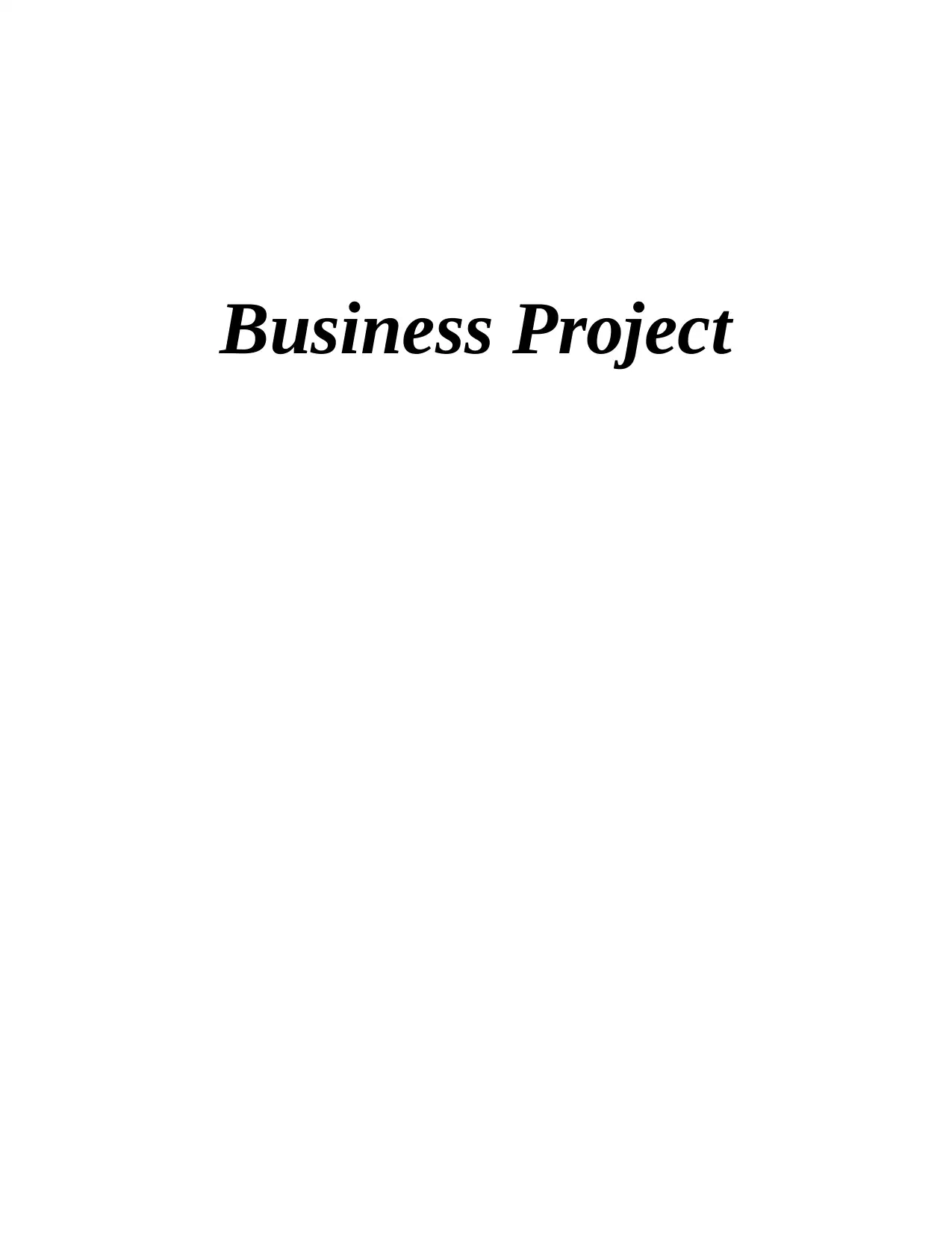
Business Project
Secure Best Marks with AI Grader
Need help grading? Try our AI Grader for instant feedback on your assignments.
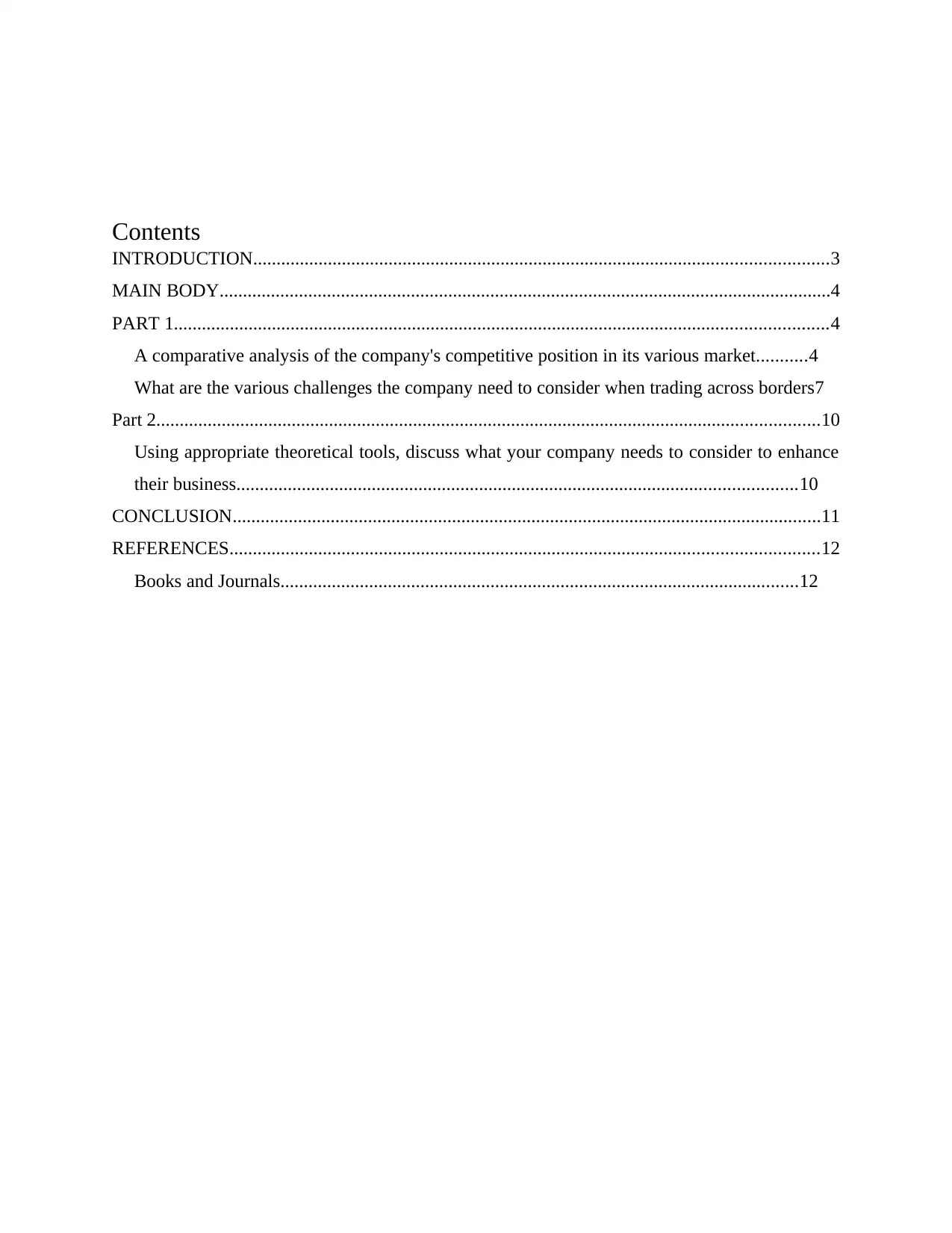
Contents
INTRODUCTION...........................................................................................................................3
MAIN BODY...................................................................................................................................4
PART 1............................................................................................................................................4
A comparative analysis of the company's competitive position in its various market...........4
What are the various challenges the company need to consider when trading across borders7
Part 2..............................................................................................................................................10
Using appropriate theoretical tools, discuss what your company needs to consider to enhance
their business........................................................................................................................10
CONCLUSION..............................................................................................................................11
REFERENCES..............................................................................................................................12
Books and Journals...............................................................................................................12
INTRODUCTION...........................................................................................................................3
MAIN BODY...................................................................................................................................4
PART 1............................................................................................................................................4
A comparative analysis of the company's competitive position in its various market...........4
What are the various challenges the company need to consider when trading across borders7
Part 2..............................................................................................................................................10
Using appropriate theoretical tools, discuss what your company needs to consider to enhance
their business........................................................................................................................10
CONCLUSION..............................................................................................................................11
REFERENCES..............................................................................................................................12
Books and Journals...............................................................................................................12
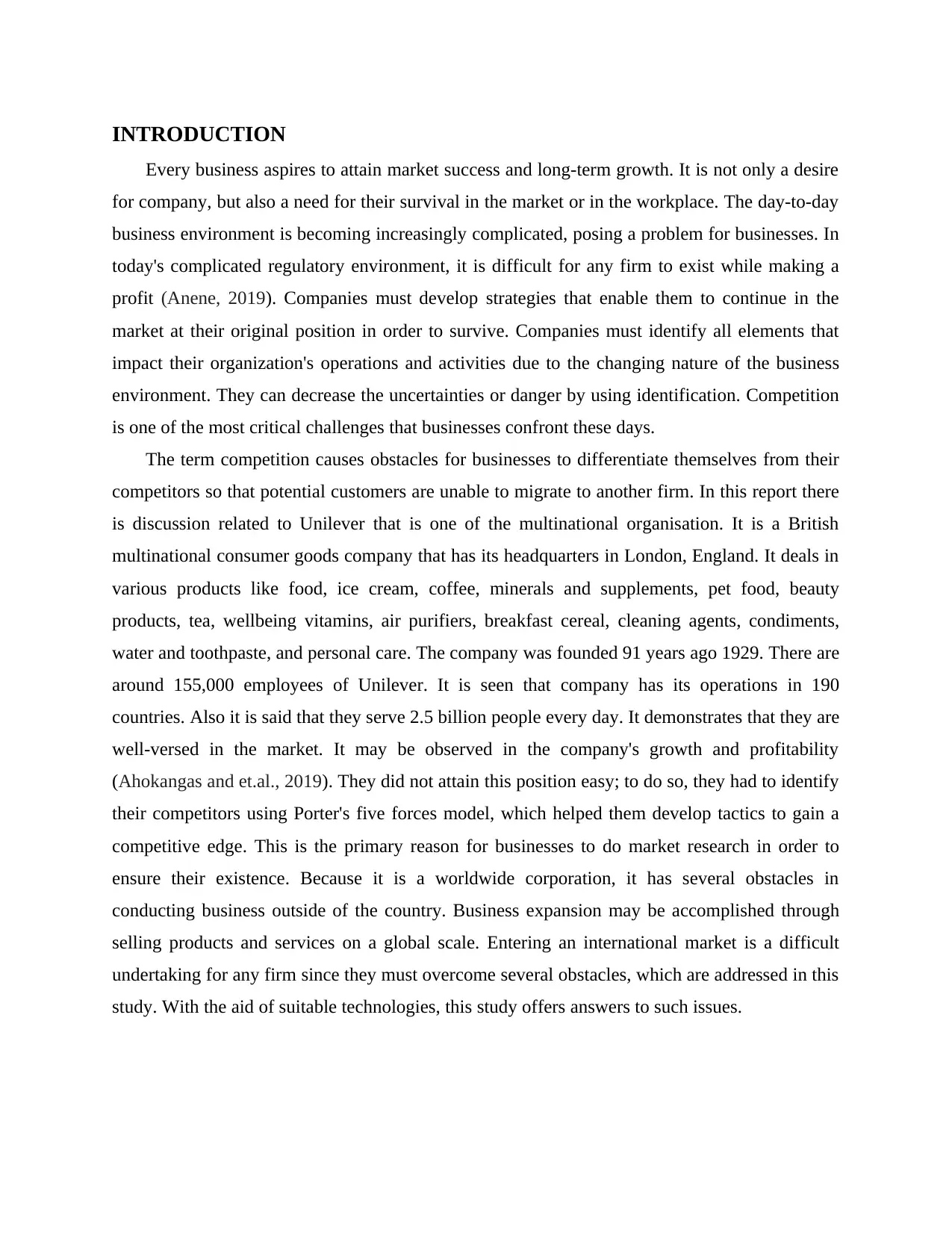
INTRODUCTION
Every business aspires to attain market success and long-term growth. It is not only a desire
for company, but also a need for their survival in the market or in the workplace. The day-to-day
business environment is becoming increasingly complicated, posing a problem for businesses. In
today's complicated regulatory environment, it is difficult for any firm to exist while making a
profit (Anene, 2019). Companies must develop strategies that enable them to continue in the
market at their original position in order to survive. Companies must identify all elements that
impact their organization's operations and activities due to the changing nature of the business
environment. They can decrease the uncertainties or danger by using identification. Competition
is one of the most critical challenges that businesses confront these days.
The term competition causes obstacles for businesses to differentiate themselves from their
competitors so that potential customers are unable to migrate to another firm. In this report there
is discussion related to Unilever that is one of the multinational organisation. It is a British
multinational consumer goods company that has its headquarters in London, England. It deals in
various products like food, ice cream, coffee, minerals and supplements, pet food, beauty
products, tea, wellbeing vitamins, air purifiers, breakfast cereal, cleaning agents, condiments,
water and toothpaste, and personal care. The company was founded 91 years ago 1929. There are
around 155,000 employees of Unilever. It is seen that company has its operations in 190
countries. Also it is said that they serve 2.5 billion people every day. It demonstrates that they are
well-versed in the market. It may be observed in the company's growth and profitability
(Ahokangas and et.al., 2019). They did not attain this position easy; to do so, they had to identify
their competitors using Porter's five forces model, which helped them develop tactics to gain a
competitive edge. This is the primary reason for businesses to do market research in order to
ensure their existence. Because it is a worldwide corporation, it has several obstacles in
conducting business outside of the country. Business expansion may be accomplished through
selling products and services on a global scale. Entering an international market is a difficult
undertaking for any firm since they must overcome several obstacles, which are addressed in this
study. With the aid of suitable technologies, this study offers answers to such issues.
Every business aspires to attain market success and long-term growth. It is not only a desire
for company, but also a need for their survival in the market or in the workplace. The day-to-day
business environment is becoming increasingly complicated, posing a problem for businesses. In
today's complicated regulatory environment, it is difficult for any firm to exist while making a
profit (Anene, 2019). Companies must develop strategies that enable them to continue in the
market at their original position in order to survive. Companies must identify all elements that
impact their organization's operations and activities due to the changing nature of the business
environment. They can decrease the uncertainties or danger by using identification. Competition
is one of the most critical challenges that businesses confront these days.
The term competition causes obstacles for businesses to differentiate themselves from their
competitors so that potential customers are unable to migrate to another firm. In this report there
is discussion related to Unilever that is one of the multinational organisation. It is a British
multinational consumer goods company that has its headquarters in London, England. It deals in
various products like food, ice cream, coffee, minerals and supplements, pet food, beauty
products, tea, wellbeing vitamins, air purifiers, breakfast cereal, cleaning agents, condiments,
water and toothpaste, and personal care. The company was founded 91 years ago 1929. There are
around 155,000 employees of Unilever. It is seen that company has its operations in 190
countries. Also it is said that they serve 2.5 billion people every day. It demonstrates that they are
well-versed in the market. It may be observed in the company's growth and profitability
(Ahokangas and et.al., 2019). They did not attain this position easy; to do so, they had to identify
their competitors using Porter's five forces model, which helped them develop tactics to gain a
competitive edge. This is the primary reason for businesses to do market research in order to
ensure their existence. Because it is a worldwide corporation, it has several obstacles in
conducting business outside of the country. Business expansion may be accomplished through
selling products and services on a global scale. Entering an international market is a difficult
undertaking for any firm since they must overcome several obstacles, which are addressed in this
study. With the aid of suitable technologies, this study offers answers to such issues.
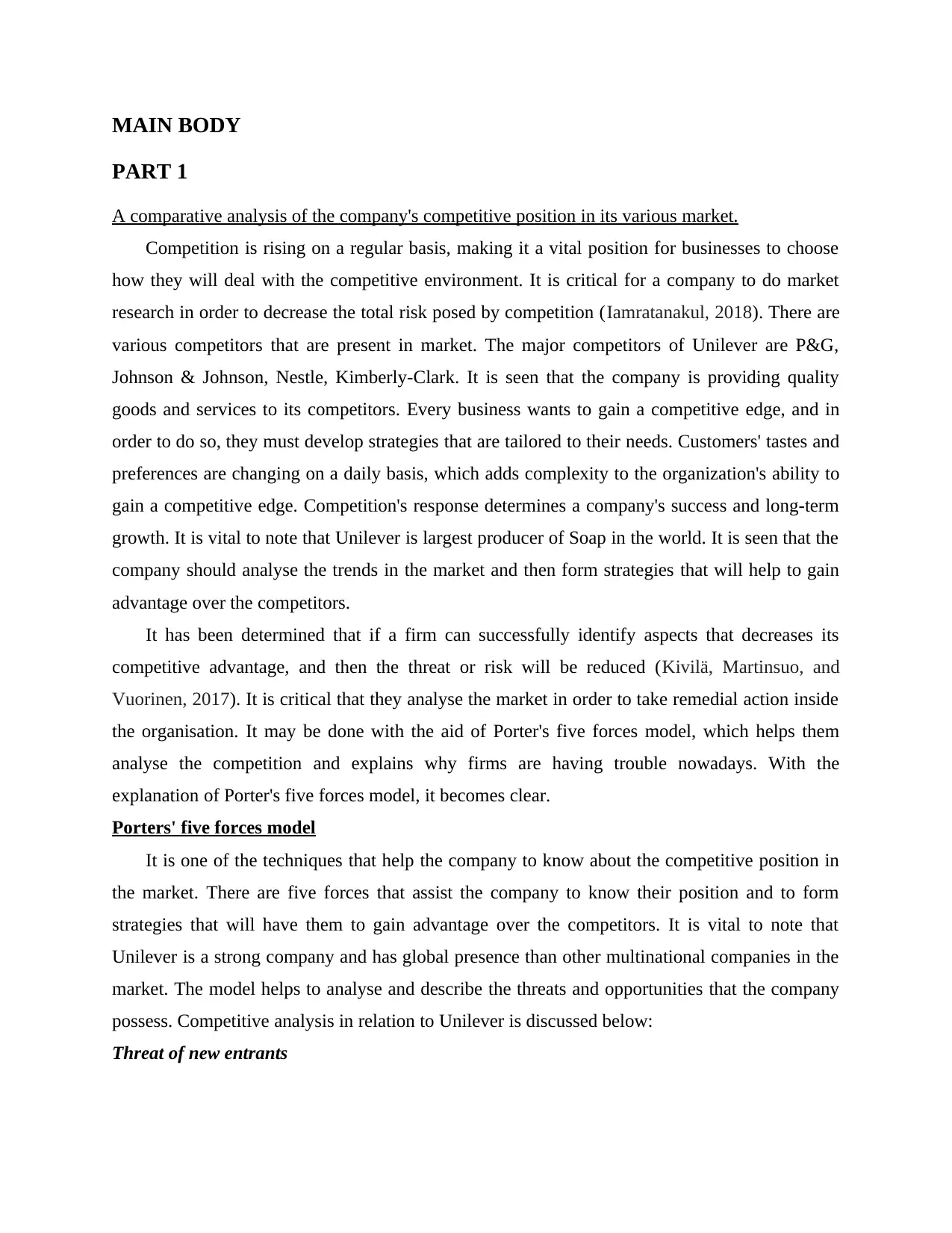
MAIN BODY
PART 1
A comparative analysis of the company's competitive position in its various market.
Competition is rising on a regular basis, making it a vital position for businesses to choose
how they will deal with the competitive environment. It is critical for a company to do market
research in order to decrease the total risk posed by competition (Iamratanakul, 2018). There are
various competitors that are present in market. The major competitors of Unilever are P&G,
Johnson & Johnson, Nestle, Kimberly-Clark. It is seen that the company is providing quality
goods and services to its competitors. Every business wants to gain a competitive edge, and in
order to do so, they must develop strategies that are tailored to their needs. Customers' tastes and
preferences are changing on a daily basis, which adds complexity to the organization's ability to
gain a competitive edge. Competition's response determines a company's success and long-term
growth. It is vital to note that Unilever is largest producer of Soap in the world. It is seen that the
company should analyse the trends in the market and then form strategies that will help to gain
advantage over the competitors.
It has been determined that if a firm can successfully identify aspects that decreases its
competitive advantage, and then the threat or risk will be reduced (Kivilä, Martinsuo, and
Vuorinen, 2017). It is critical that they analyse the market in order to take remedial action inside
the organisation. It may be done with the aid of Porter's five forces model, which helps them
analyse the competition and explains why firms are having trouble nowadays. With the
explanation of Porter's five forces model, it becomes clear.
Porters' five forces model
It is one of the techniques that help the company to know about the competitive position in
the market. There are five forces that assist the company to know their position and to form
strategies that will have them to gain advantage over the competitors. It is vital to note that
Unilever is a strong company and has global presence than other multinational companies in the
market. The model helps to analyse and describe the threats and opportunities that the company
possess. Competitive analysis in relation to Unilever is discussed below:
Threat of new entrants
PART 1
A comparative analysis of the company's competitive position in its various market.
Competition is rising on a regular basis, making it a vital position for businesses to choose
how they will deal with the competitive environment. It is critical for a company to do market
research in order to decrease the total risk posed by competition (Iamratanakul, 2018). There are
various competitors that are present in market. The major competitors of Unilever are P&G,
Johnson & Johnson, Nestle, Kimberly-Clark. It is seen that the company is providing quality
goods and services to its competitors. Every business wants to gain a competitive edge, and in
order to do so, they must develop strategies that are tailored to their needs. Customers' tastes and
preferences are changing on a daily basis, which adds complexity to the organization's ability to
gain a competitive edge. Competition's response determines a company's success and long-term
growth. It is vital to note that Unilever is largest producer of Soap in the world. It is seen that the
company should analyse the trends in the market and then form strategies that will help to gain
advantage over the competitors.
It has been determined that if a firm can successfully identify aspects that decreases its
competitive advantage, and then the threat or risk will be reduced (Kivilä, Martinsuo, and
Vuorinen, 2017). It is critical that they analyse the market in order to take remedial action inside
the organisation. It may be done with the aid of Porter's five forces model, which helps them
analyse the competition and explains why firms are having trouble nowadays. With the
explanation of Porter's five forces model, it becomes clear.
Porters' five forces model
It is one of the techniques that help the company to know about the competitive position in
the market. There are five forces that assist the company to know their position and to form
strategies that will have them to gain advantage over the competitors. It is vital to note that
Unilever is a strong company and has global presence than other multinational companies in the
market. The model helps to analyse and describe the threats and opportunities that the company
possess. Competitive analysis in relation to Unilever is discussed below:
Threat of new entrants
Secure Best Marks with AI Grader
Need help grading? Try our AI Grader for instant feedback on your assignments.
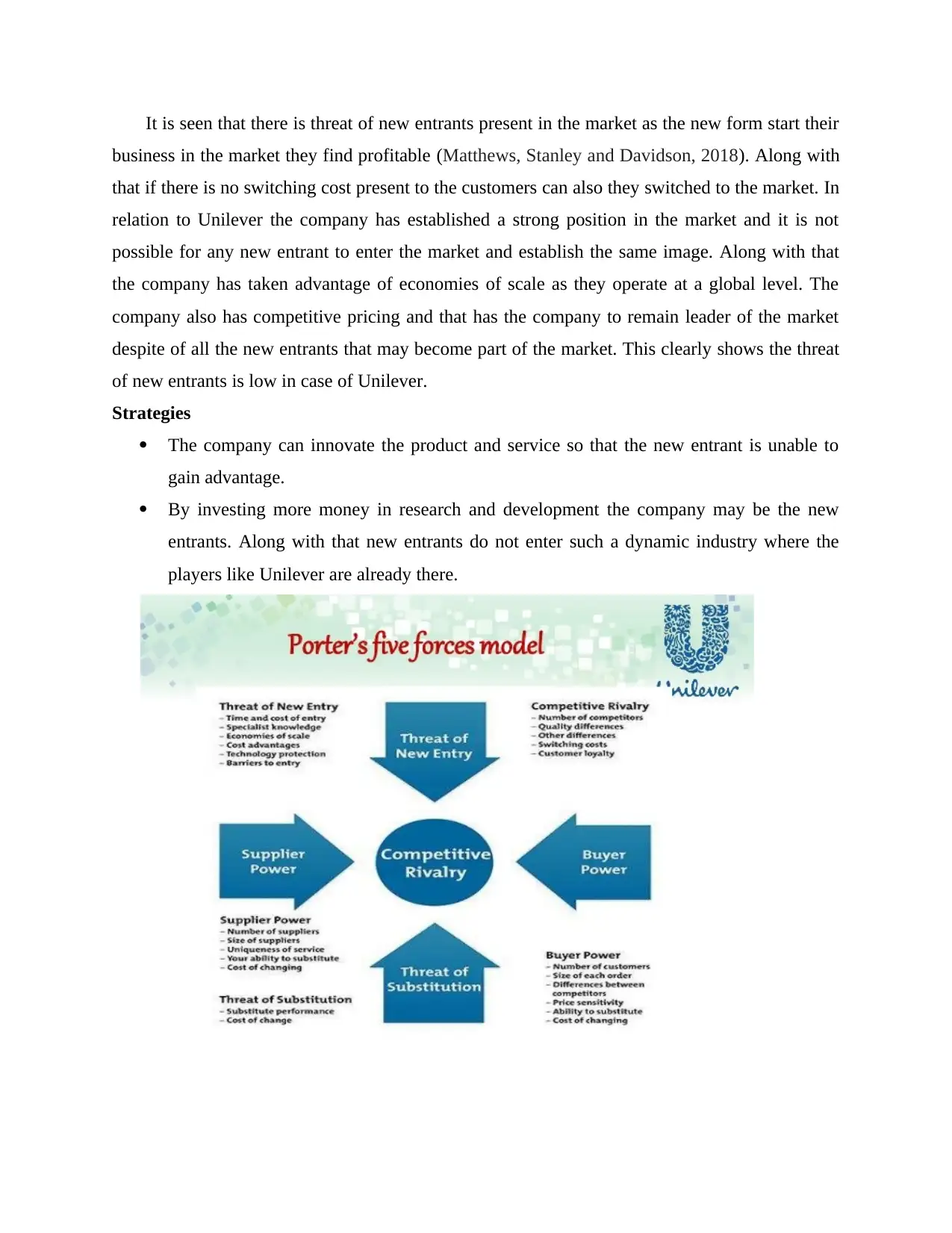
It is seen that there is threat of new entrants present in the market as the new form start their
business in the market they find profitable (Matthews, Stanley and Davidson, 2018). Along with
that if there is no switching cost present to the customers can also they switched to the market. In
relation to Unilever the company has established a strong position in the market and it is not
possible for any new entrant to enter the market and establish the same image. Along with that
the company has taken advantage of economies of scale as they operate at a global level. The
company also has competitive pricing and that has the company to remain leader of the market
despite of all the new entrants that may become part of the market. This clearly shows the threat
of new entrants is low in case of Unilever.
Strategies
The company can innovate the product and service so that the new entrant is unable to
gain advantage.
By investing more money in research and development the company may be the new
entrants. Along with that new entrants do not enter such a dynamic industry where the
players like Unilever are already there.
business in the market they find profitable (Matthews, Stanley and Davidson, 2018). Along with
that if there is no switching cost present to the customers can also they switched to the market. In
relation to Unilever the company has established a strong position in the market and it is not
possible for any new entrant to enter the market and establish the same image. Along with that
the company has taken advantage of economies of scale as they operate at a global level. The
company also has competitive pricing and that has the company to remain leader of the market
despite of all the new entrants that may become part of the market. This clearly shows the threat
of new entrants is low in case of Unilever.
Strategies
The company can innovate the product and service so that the new entrant is unable to
gain advantage.
By investing more money in research and development the company may be the new
entrants. Along with that new entrants do not enter such a dynamic industry where the
players like Unilever are already there.
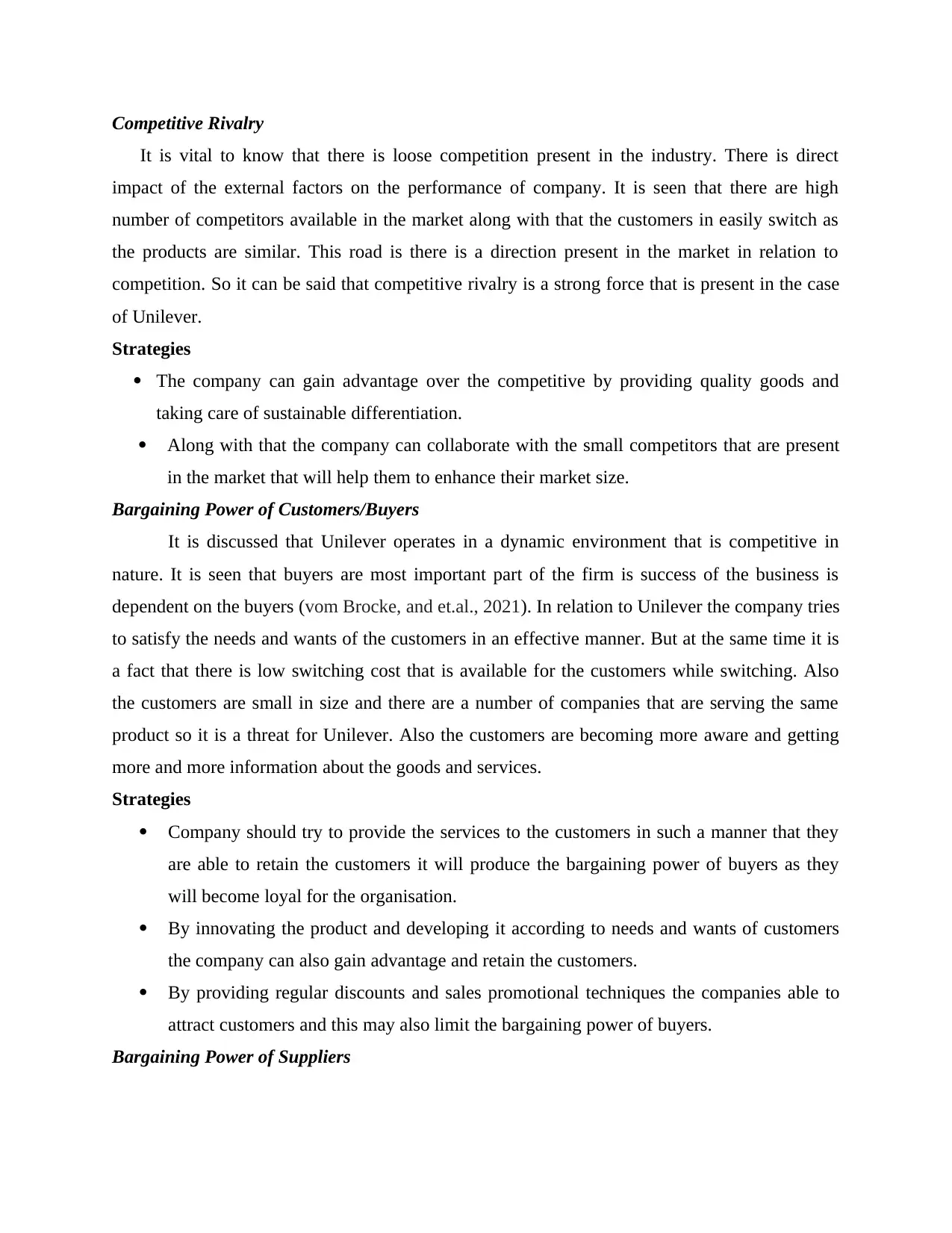
Competitive Rivalry
It is vital to know that there is loose competition present in the industry. There is direct
impact of the external factors on the performance of company. It is seen that there are high
number of competitors available in the market along with that the customers in easily switch as
the products are similar. This road is there is a direction present in the market in relation to
competition. So it can be said that competitive rivalry is a strong force that is present in the case
of Unilever.
Strategies
The company can gain advantage over the competitive by providing quality goods and
taking care of sustainable differentiation.
Along with that the company can collaborate with the small competitors that are present
in the market that will help them to enhance their market size.
Bargaining Power of Customers/Buyers
It is discussed that Unilever operates in a dynamic environment that is competitive in
nature. It is seen that buyers are most important part of the firm is success of the business is
dependent on the buyers (vom Brocke, and et.al., 2021). In relation to Unilever the company tries
to satisfy the needs and wants of the customers in an effective manner. But at the same time it is
a fact that there is low switching cost that is available for the customers while switching. Also
the customers are small in size and there are a number of companies that are serving the same
product so it is a threat for Unilever. Also the customers are becoming more aware and getting
more and more information about the goods and services.
Strategies
Company should try to provide the services to the customers in such a manner that they
are able to retain the customers it will produce the bargaining power of buyers as they
will become loyal for the organisation.
By innovating the product and developing it according to needs and wants of customers
the company can also gain advantage and retain the customers.
By providing regular discounts and sales promotional techniques the companies able to
attract customers and this may also limit the bargaining power of buyers.
Bargaining Power of Suppliers
It is vital to know that there is loose competition present in the industry. There is direct
impact of the external factors on the performance of company. It is seen that there are high
number of competitors available in the market along with that the customers in easily switch as
the products are similar. This road is there is a direction present in the market in relation to
competition. So it can be said that competitive rivalry is a strong force that is present in the case
of Unilever.
Strategies
The company can gain advantage over the competitive by providing quality goods and
taking care of sustainable differentiation.
Along with that the company can collaborate with the small competitors that are present
in the market that will help them to enhance their market size.
Bargaining Power of Customers/Buyers
It is discussed that Unilever operates in a dynamic environment that is competitive in
nature. It is seen that buyers are most important part of the firm is success of the business is
dependent on the buyers (vom Brocke, and et.al., 2021). In relation to Unilever the company tries
to satisfy the needs and wants of the customers in an effective manner. But at the same time it is
a fact that there is low switching cost that is available for the customers while switching. Also
the customers are small in size and there are a number of companies that are serving the same
product so it is a threat for Unilever. Also the customers are becoming more aware and getting
more and more information about the goods and services.
Strategies
Company should try to provide the services to the customers in such a manner that they
are able to retain the customers it will produce the bargaining power of buyers as they
will become loyal for the organisation.
By innovating the product and developing it according to needs and wants of customers
the company can also gain advantage and retain the customers.
By providing regular discounts and sales promotional techniques the companies able to
attract customers and this may also limit the bargaining power of buyers.
Bargaining Power of Suppliers
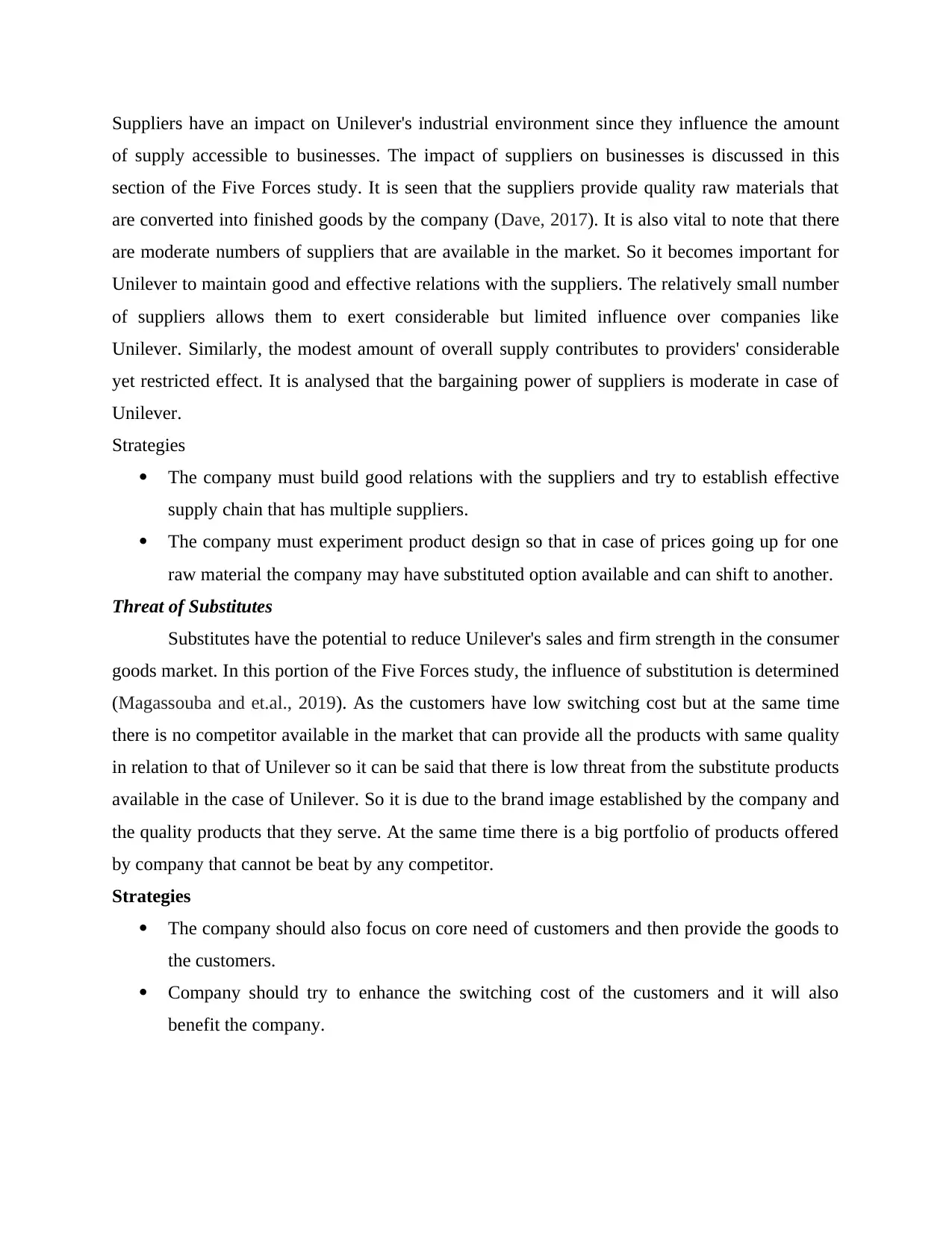
Suppliers have an impact on Unilever's industrial environment since they influence the amount
of supply accessible to businesses. The impact of suppliers on businesses is discussed in this
section of the Five Forces study. It is seen that the suppliers provide quality raw materials that
are converted into finished goods by the company (Dave, 2017). It is also vital to note that there
are moderate numbers of suppliers that are available in the market. So it becomes important for
Unilever to maintain good and effective relations with the suppliers. The relatively small number
of suppliers allows them to exert considerable but limited influence over companies like
Unilever. Similarly, the modest amount of overall supply contributes to providers' considerable
yet restricted effect. It is analysed that the bargaining power of suppliers is moderate in case of
Unilever.
Strategies
The company must build good relations with the suppliers and try to establish effective
supply chain that has multiple suppliers.
The company must experiment product design so that in case of prices going up for one
raw material the company may have substituted option available and can shift to another.
Threat of Substitutes
Substitutes have the potential to reduce Unilever's sales and firm strength in the consumer
goods market. In this portion of the Five Forces study, the influence of substitution is determined
(Magassouba and et.al., 2019). As the customers have low switching cost but at the same time
there is no competitor available in the market that can provide all the products with same quality
in relation to that of Unilever so it can be said that there is low threat from the substitute products
available in the case of Unilever. So it is due to the brand image established by the company and
the quality products that they serve. At the same time there is a big portfolio of products offered
by company that cannot be beat by any competitor.
Strategies
The company should also focus on core need of customers and then provide the goods to
the customers.
Company should try to enhance the switching cost of the customers and it will also
benefit the company.
of supply accessible to businesses. The impact of suppliers on businesses is discussed in this
section of the Five Forces study. It is seen that the suppliers provide quality raw materials that
are converted into finished goods by the company (Dave, 2017). It is also vital to note that there
are moderate numbers of suppliers that are available in the market. So it becomes important for
Unilever to maintain good and effective relations with the suppliers. The relatively small number
of suppliers allows them to exert considerable but limited influence over companies like
Unilever. Similarly, the modest amount of overall supply contributes to providers' considerable
yet restricted effect. It is analysed that the bargaining power of suppliers is moderate in case of
Unilever.
Strategies
The company must build good relations with the suppliers and try to establish effective
supply chain that has multiple suppliers.
The company must experiment product design so that in case of prices going up for one
raw material the company may have substituted option available and can shift to another.
Threat of Substitutes
Substitutes have the potential to reduce Unilever's sales and firm strength in the consumer
goods market. In this portion of the Five Forces study, the influence of substitution is determined
(Magassouba and et.al., 2019). As the customers have low switching cost but at the same time
there is no competitor available in the market that can provide all the products with same quality
in relation to that of Unilever so it can be said that there is low threat from the substitute products
available in the case of Unilever. So it is due to the brand image established by the company and
the quality products that they serve. At the same time there is a big portfolio of products offered
by company that cannot be beat by any competitor.
Strategies
The company should also focus on core need of customers and then provide the goods to
the customers.
Company should try to enhance the switching cost of the customers and it will also
benefit the company.
Paraphrase This Document
Need a fresh take? Get an instant paraphrase of this document with our AI Paraphraser
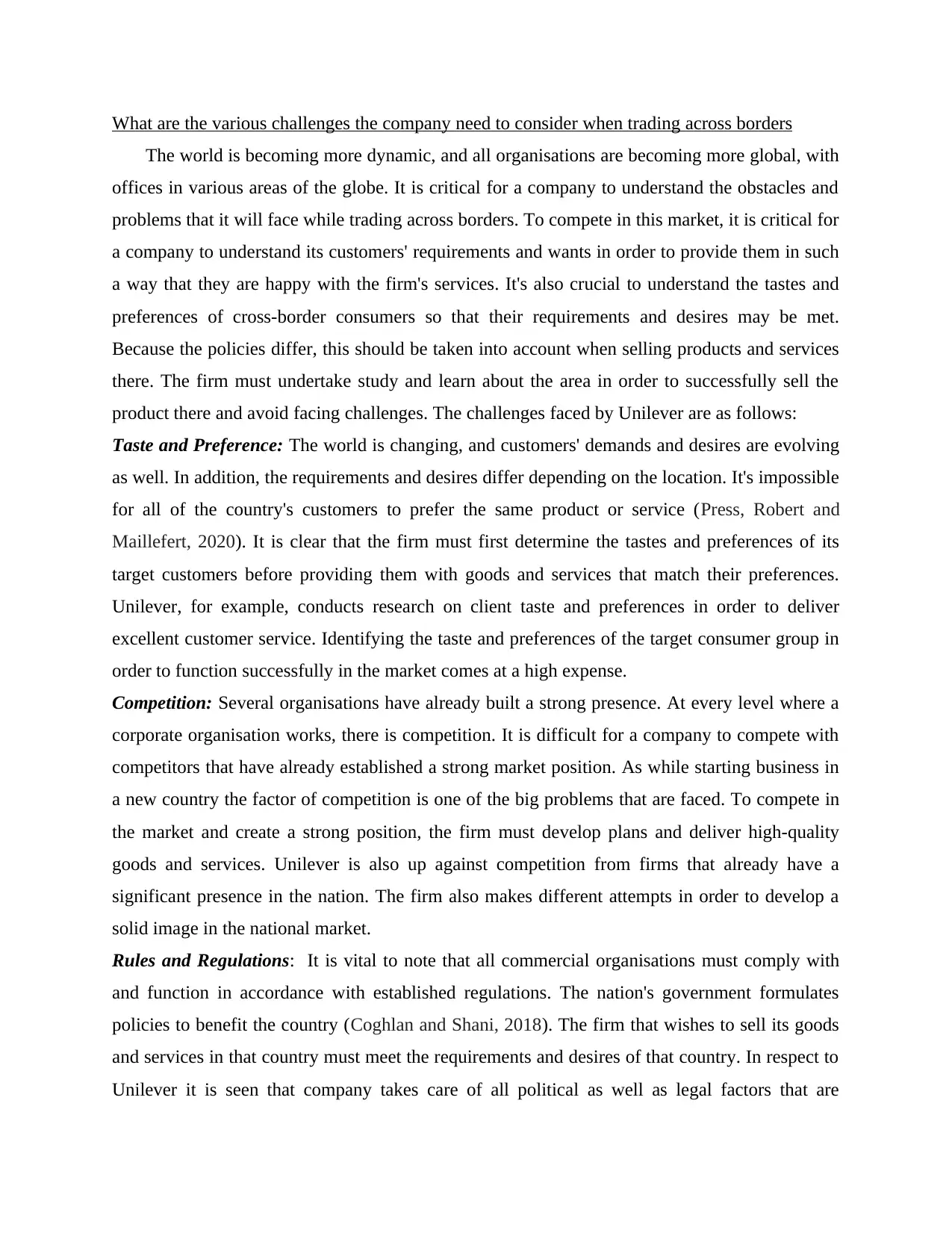
What are the various challenges the company need to consider when trading across borders
The world is becoming more dynamic, and all organisations are becoming more global, with
offices in various areas of the globe. It is critical for a company to understand the obstacles and
problems that it will face while trading across borders. To compete in this market, it is critical for
a company to understand its customers' requirements and wants in order to provide them in such
a way that they are happy with the firm's services. It's also crucial to understand the tastes and
preferences of cross-border consumers so that their requirements and desires may be met.
Because the policies differ, this should be taken into account when selling products and services
there. The firm must undertake study and learn about the area in order to successfully sell the
product there and avoid facing challenges. The challenges faced by Unilever are as follows:
Taste and Preference: The world is changing, and customers' demands and desires are evolving
as well. In addition, the requirements and desires differ depending on the location. It's impossible
for all of the country's customers to prefer the same product or service (Press, Robert and
Maillefert, 2020). It is clear that the firm must first determine the tastes and preferences of its
target customers before providing them with goods and services that match their preferences.
Unilever, for example, conducts research on client taste and preferences in order to deliver
excellent customer service. Identifying the taste and preferences of the target consumer group in
order to function successfully in the market comes at a high expense.
Competition: Several organisations have already built a strong presence. At every level where a
corporate organisation works, there is competition. It is difficult for a company to compete with
competitors that have already established a strong market position. As while starting business in
a new country the factor of competition is one of the big problems that are faced. To compete in
the market and create a strong position, the firm must develop plans and deliver high-quality
goods and services. Unilever is also up against competition from firms that already have a
significant presence in the nation. The firm also makes different attempts in order to develop a
solid image in the national market.
Rules and Regulations: It is vital to note that all commercial organisations must comply with
and function in accordance with established regulations. The nation's government formulates
policies to benefit the country (Coghlan and Shani, 2018). The firm that wishes to sell its goods
and services in that country must meet the requirements and desires of that country. In respect to
Unilever it is seen that company takes care of all political as well as legal factors that are
The world is becoming more dynamic, and all organisations are becoming more global, with
offices in various areas of the globe. It is critical for a company to understand the obstacles and
problems that it will face while trading across borders. To compete in this market, it is critical for
a company to understand its customers' requirements and wants in order to provide them in such
a way that they are happy with the firm's services. It's also crucial to understand the tastes and
preferences of cross-border consumers so that their requirements and desires may be met.
Because the policies differ, this should be taken into account when selling products and services
there. The firm must undertake study and learn about the area in order to successfully sell the
product there and avoid facing challenges. The challenges faced by Unilever are as follows:
Taste and Preference: The world is changing, and customers' demands and desires are evolving
as well. In addition, the requirements and desires differ depending on the location. It's impossible
for all of the country's customers to prefer the same product or service (Press, Robert and
Maillefert, 2020). It is clear that the firm must first determine the tastes and preferences of its
target customers before providing them with goods and services that match their preferences.
Unilever, for example, conducts research on client taste and preferences in order to deliver
excellent customer service. Identifying the taste and preferences of the target consumer group in
order to function successfully in the market comes at a high expense.
Competition: Several organisations have already built a strong presence. At every level where a
corporate organisation works, there is competition. It is difficult for a company to compete with
competitors that have already established a strong market position. As while starting business in
a new country the factor of competition is one of the big problems that are faced. To compete in
the market and create a strong position, the firm must develop plans and deliver high-quality
goods and services. Unilever is also up against competition from firms that already have a
significant presence in the nation. The firm also makes different attempts in order to develop a
solid image in the national market.
Rules and Regulations: It is vital to note that all commercial organisations must comply with
and function in accordance with established regulations. The nation's government formulates
policies to benefit the country (Coghlan and Shani, 2018). The firm that wishes to sell its goods
and services in that country must meet the requirements and desires of that country. In respect to
Unilever it is seen that company takes care of all political as well as legal factors that are
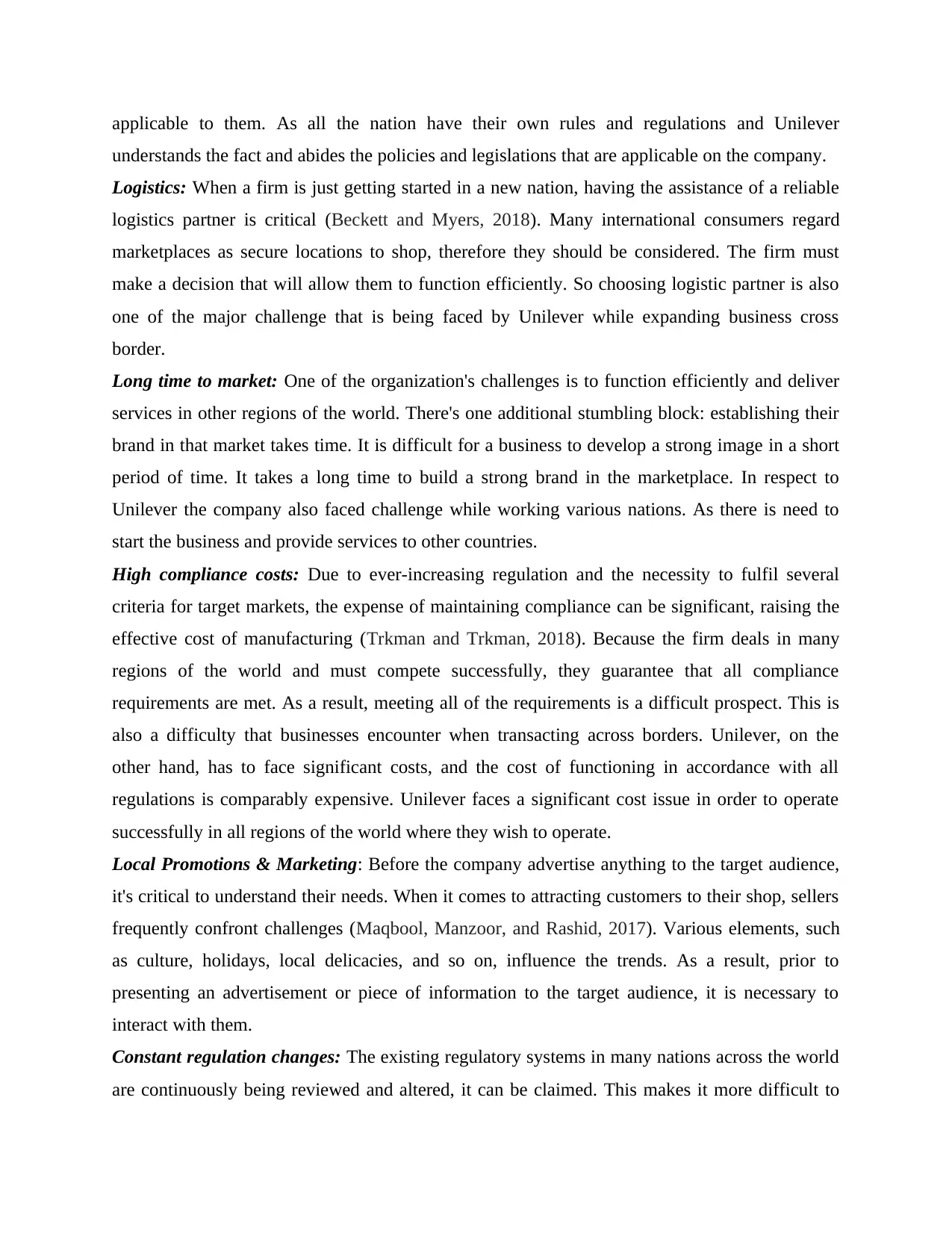
applicable to them. As all the nation have their own rules and regulations and Unilever
understands the fact and abides the policies and legislations that are applicable on the company.
Logistics: When a firm is just getting started in a new nation, having the assistance of a reliable
logistics partner is critical (Beckett and Myers, 2018). Many international consumers regard
marketplaces as secure locations to shop, therefore they should be considered. The firm must
make a decision that will allow them to function efficiently. So choosing logistic partner is also
one of the major challenge that is being faced by Unilever while expanding business cross
border.
Long time to market: One of the organization's challenges is to function efficiently and deliver
services in other regions of the world. There's one additional stumbling block: establishing their
brand in that market takes time. It is difficult for a business to develop a strong image in a short
period of time. It takes a long time to build a strong brand in the marketplace. In respect to
Unilever the company also faced challenge while working various nations. As there is need to
start the business and provide services to other countries.
High compliance costs: Due to ever-increasing regulation and the necessity to fulfil several
criteria for target markets, the expense of maintaining compliance can be significant, raising the
effective cost of manufacturing (Trkman and Trkman, 2018). Because the firm deals in many
regions of the world and must compete successfully, they guarantee that all compliance
requirements are met. As a result, meeting all of the requirements is a difficult prospect. This is
also a difficulty that businesses encounter when transacting across borders. Unilever, on the
other hand, has to face significant costs, and the cost of functioning in accordance with all
regulations is comparably expensive. Unilever faces a significant cost issue in order to operate
successfully in all regions of the world where they wish to operate.
Local Promotions & Marketing: Before the company advertise anything to the target audience,
it's critical to understand their needs. When it comes to attracting customers to their shop, sellers
frequently confront challenges (Maqbool, Manzoor, and Rashid, 2017). Various elements, such
as culture, holidays, local delicacies, and so on, influence the trends. As a result, prior to
presenting an advertisement or piece of information to the target audience, it is necessary to
interact with them.
Constant regulation changes: The existing regulatory systems in many nations across the world
are continuously being reviewed and altered, it can be claimed. This makes it more difficult to
understands the fact and abides the policies and legislations that are applicable on the company.
Logistics: When a firm is just getting started in a new nation, having the assistance of a reliable
logistics partner is critical (Beckett and Myers, 2018). Many international consumers regard
marketplaces as secure locations to shop, therefore they should be considered. The firm must
make a decision that will allow them to function efficiently. So choosing logistic partner is also
one of the major challenge that is being faced by Unilever while expanding business cross
border.
Long time to market: One of the organization's challenges is to function efficiently and deliver
services in other regions of the world. There's one additional stumbling block: establishing their
brand in that market takes time. It is difficult for a business to develop a strong image in a short
period of time. It takes a long time to build a strong brand in the marketplace. In respect to
Unilever the company also faced challenge while working various nations. As there is need to
start the business and provide services to other countries.
High compliance costs: Due to ever-increasing regulation and the necessity to fulfil several
criteria for target markets, the expense of maintaining compliance can be significant, raising the
effective cost of manufacturing (Trkman and Trkman, 2018). Because the firm deals in many
regions of the world and must compete successfully, they guarantee that all compliance
requirements are met. As a result, meeting all of the requirements is a difficult prospect. This is
also a difficulty that businesses encounter when transacting across borders. Unilever, on the
other hand, has to face significant costs, and the cost of functioning in accordance with all
regulations is comparably expensive. Unilever faces a significant cost issue in order to operate
successfully in all regions of the world where they wish to operate.
Local Promotions & Marketing: Before the company advertise anything to the target audience,
it's critical to understand their needs. When it comes to attracting customers to their shop, sellers
frequently confront challenges (Maqbool, Manzoor, and Rashid, 2017). Various elements, such
as culture, holidays, local delicacies, and so on, influence the trends. As a result, prior to
presenting an advertisement or piece of information to the target audience, it is necessary to
interact with them.
Constant regulation changes: The existing regulatory systems in many nations across the world
are continuously being reviewed and altered, it can be claimed. This makes it more difficult to
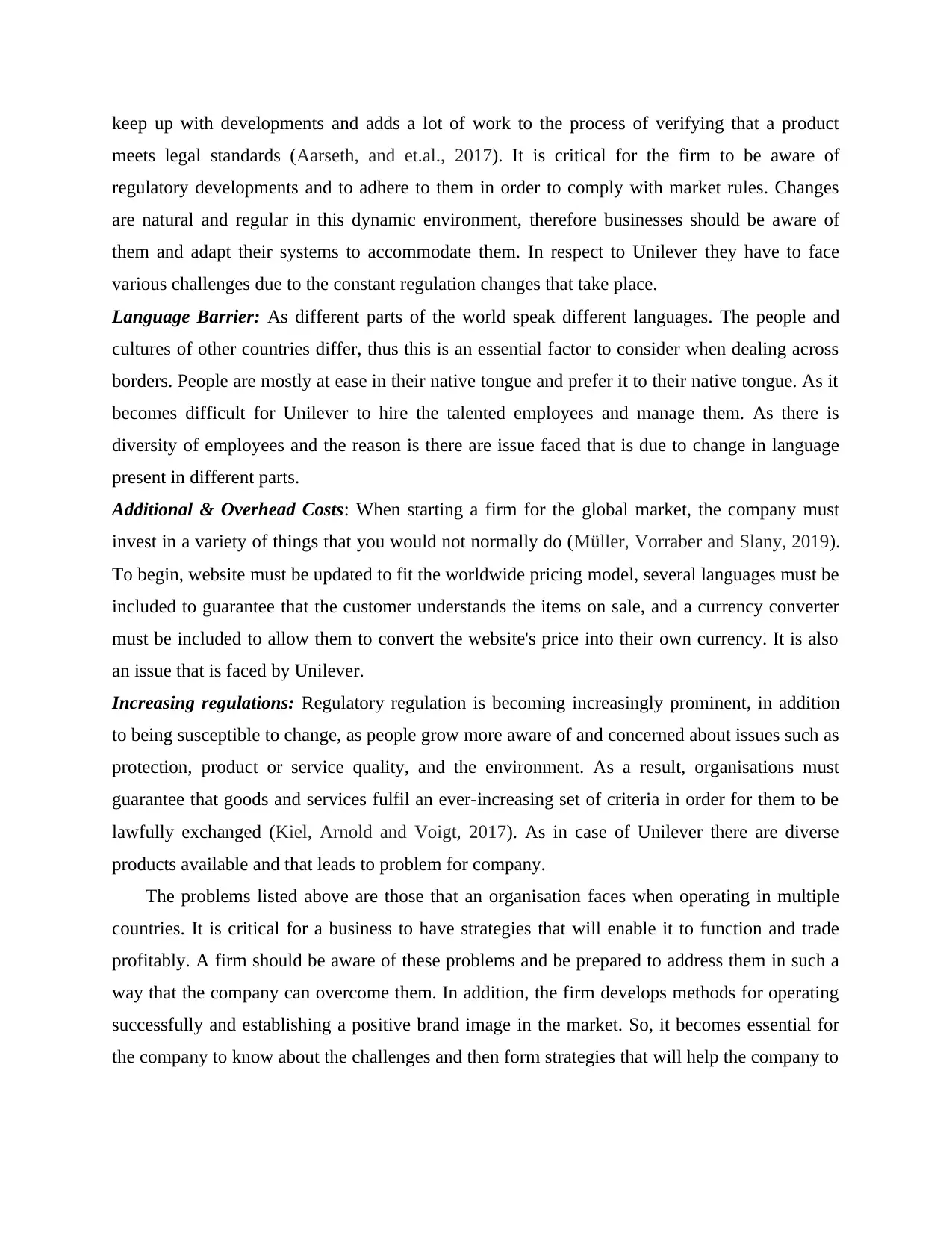
keep up with developments and adds a lot of work to the process of verifying that a product
meets legal standards (Aarseth, and et.al., 2017). It is critical for the firm to be aware of
regulatory developments and to adhere to them in order to comply with market rules. Changes
are natural and regular in this dynamic environment, therefore businesses should be aware of
them and adapt their systems to accommodate them. In respect to Unilever they have to face
various challenges due to the constant regulation changes that take place.
Language Barrier: As different parts of the world speak different languages. The people and
cultures of other countries differ, thus this is an essential factor to consider when dealing across
borders. People are mostly at ease in their native tongue and prefer it to their native tongue. As it
becomes difficult for Unilever to hire the talented employees and manage them. As there is
diversity of employees and the reason is there are issue faced that is due to change in language
present in different parts.
Additional & Overhead Costs: When starting a firm for the global market, the company must
invest in a variety of things that you would not normally do (Müller, Vorraber and Slany, 2019).
To begin, website must be updated to fit the worldwide pricing model, several languages must be
included to guarantee that the customer understands the items on sale, and a currency converter
must be included to allow them to convert the website's price into their own currency. It is also
an issue that is faced by Unilever.
Increasing regulations: Regulatory regulation is becoming increasingly prominent, in addition
to being susceptible to change, as people grow more aware of and concerned about issues such as
protection, product or service quality, and the environment. As a result, organisations must
guarantee that goods and services fulfil an ever-increasing set of criteria in order for them to be
lawfully exchanged (Kiel, Arnold and Voigt, 2017). As in case of Unilever there are diverse
products available and that leads to problem for company.
The problems listed above are those that an organisation faces when operating in multiple
countries. It is critical for a business to have strategies that will enable it to function and trade
profitably. A firm should be aware of these problems and be prepared to address them in such a
way that the company can overcome them. In addition, the firm develops methods for operating
successfully and establishing a positive brand image in the market. So, it becomes essential for
the company to know about the challenges and then form strategies that will help the company to
meets legal standards (Aarseth, and et.al., 2017). It is critical for the firm to be aware of
regulatory developments and to adhere to them in order to comply with market rules. Changes
are natural and regular in this dynamic environment, therefore businesses should be aware of
them and adapt their systems to accommodate them. In respect to Unilever they have to face
various challenges due to the constant regulation changes that take place.
Language Barrier: As different parts of the world speak different languages. The people and
cultures of other countries differ, thus this is an essential factor to consider when dealing across
borders. People are mostly at ease in their native tongue and prefer it to their native tongue. As it
becomes difficult for Unilever to hire the talented employees and manage them. As there is
diversity of employees and the reason is there are issue faced that is due to change in language
present in different parts.
Additional & Overhead Costs: When starting a firm for the global market, the company must
invest in a variety of things that you would not normally do (Müller, Vorraber and Slany, 2019).
To begin, website must be updated to fit the worldwide pricing model, several languages must be
included to guarantee that the customer understands the items on sale, and a currency converter
must be included to allow them to convert the website's price into their own currency. It is also
an issue that is faced by Unilever.
Increasing regulations: Regulatory regulation is becoming increasingly prominent, in addition
to being susceptible to change, as people grow more aware of and concerned about issues such as
protection, product or service quality, and the environment. As a result, organisations must
guarantee that goods and services fulfil an ever-increasing set of criteria in order for them to be
lawfully exchanged (Kiel, Arnold and Voigt, 2017). As in case of Unilever there are diverse
products available and that leads to problem for company.
The problems listed above are those that an organisation faces when operating in multiple
countries. It is critical for a business to have strategies that will enable it to function and trade
profitably. A firm should be aware of these problems and be prepared to address them in such a
way that the company can overcome them. In addition, the firm develops methods for operating
successfully and establishing a positive brand image in the market. So, it becomes essential for
the company to know about the challenges and then form strategies that will help the company to
Secure Best Marks with AI Grader
Need help grading? Try our AI Grader for instant feedback on your assignments.
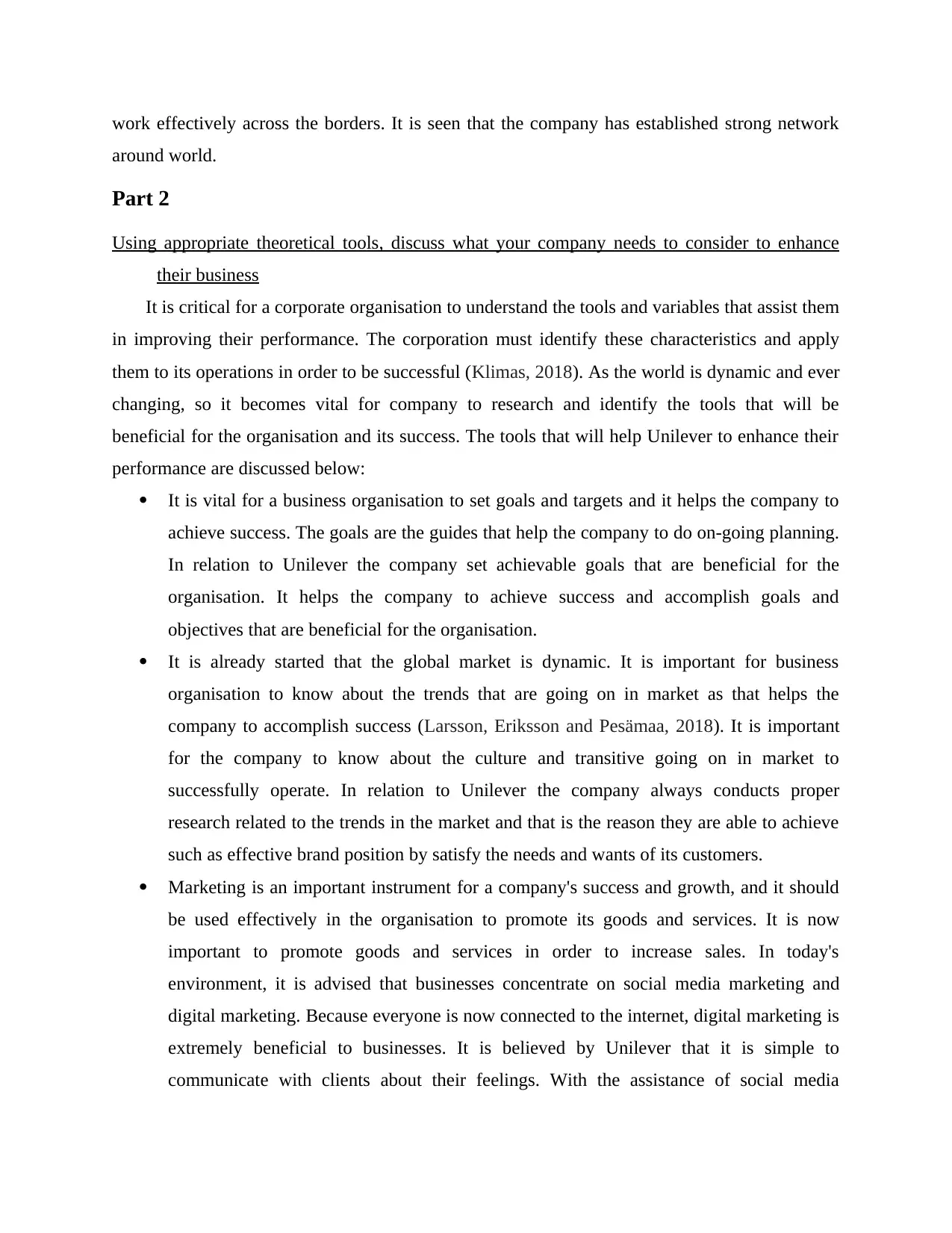
work effectively across the borders. It is seen that the company has established strong network
around world.
Part 2
Using appropriate theoretical tools, discuss what your company needs to consider to enhance
their business
It is critical for a corporate organisation to understand the tools and variables that assist them
in improving their performance. The corporation must identify these characteristics and apply
them to its operations in order to be successful (Klimas, 2018). As the world is dynamic and ever
changing, so it becomes vital for company to research and identify the tools that will be
beneficial for the organisation and its success. The tools that will help Unilever to enhance their
performance are discussed below:
It is vital for a business organisation to set goals and targets and it helps the company to
achieve success. The goals are the guides that help the company to do on-going planning.
In relation to Unilever the company set achievable goals that are beneficial for the
organisation. It helps the company to achieve success and accomplish goals and
objectives that are beneficial for the organisation.
It is already started that the global market is dynamic. It is important for business
organisation to know about the trends that are going on in market as that helps the
company to accomplish success (Larsson, Eriksson and Pesämaa, 2018). It is important
for the company to know about the culture and transitive going on in market to
successfully operate. In relation to Unilever the company always conducts proper
research related to the trends in the market and that is the reason they are able to achieve
such as effective brand position by satisfy the needs and wants of its customers.
Marketing is an important instrument for a company's success and growth, and it should
be used effectively in the organisation to promote its goods and services. It is now
important to promote goods and services in order to increase sales. In today's
environment, it is advised that businesses concentrate on social media marketing and
digital marketing. Because everyone is now connected to the internet, digital marketing is
extremely beneficial to businesses. It is believed by Unilever that it is simple to
communicate with clients about their feelings. With the assistance of social media
around world.
Part 2
Using appropriate theoretical tools, discuss what your company needs to consider to enhance
their business
It is critical for a corporate organisation to understand the tools and variables that assist them
in improving their performance. The corporation must identify these characteristics and apply
them to its operations in order to be successful (Klimas, 2018). As the world is dynamic and ever
changing, so it becomes vital for company to research and identify the tools that will be
beneficial for the organisation and its success. The tools that will help Unilever to enhance their
performance are discussed below:
It is vital for a business organisation to set goals and targets and it helps the company to
achieve success. The goals are the guides that help the company to do on-going planning.
In relation to Unilever the company set achievable goals that are beneficial for the
organisation. It helps the company to achieve success and accomplish goals and
objectives that are beneficial for the organisation.
It is already started that the global market is dynamic. It is important for business
organisation to know about the trends that are going on in market as that helps the
company to accomplish success (Larsson, Eriksson and Pesämaa, 2018). It is important
for the company to know about the culture and transitive going on in market to
successfully operate. In relation to Unilever the company always conducts proper
research related to the trends in the market and that is the reason they are able to achieve
such as effective brand position by satisfy the needs and wants of its customers.
Marketing is an important instrument for a company's success and growth, and it should
be used effectively in the organisation to promote its goods and services. It is now
important to promote goods and services in order to increase sales. In today's
environment, it is advised that businesses concentrate on social media marketing and
digital marketing. Because everyone is now connected to the internet, digital marketing is
extremely beneficial to businesses. It is believed by Unilever that it is simple to
communicate with clients about their feelings. With the assistance of social media
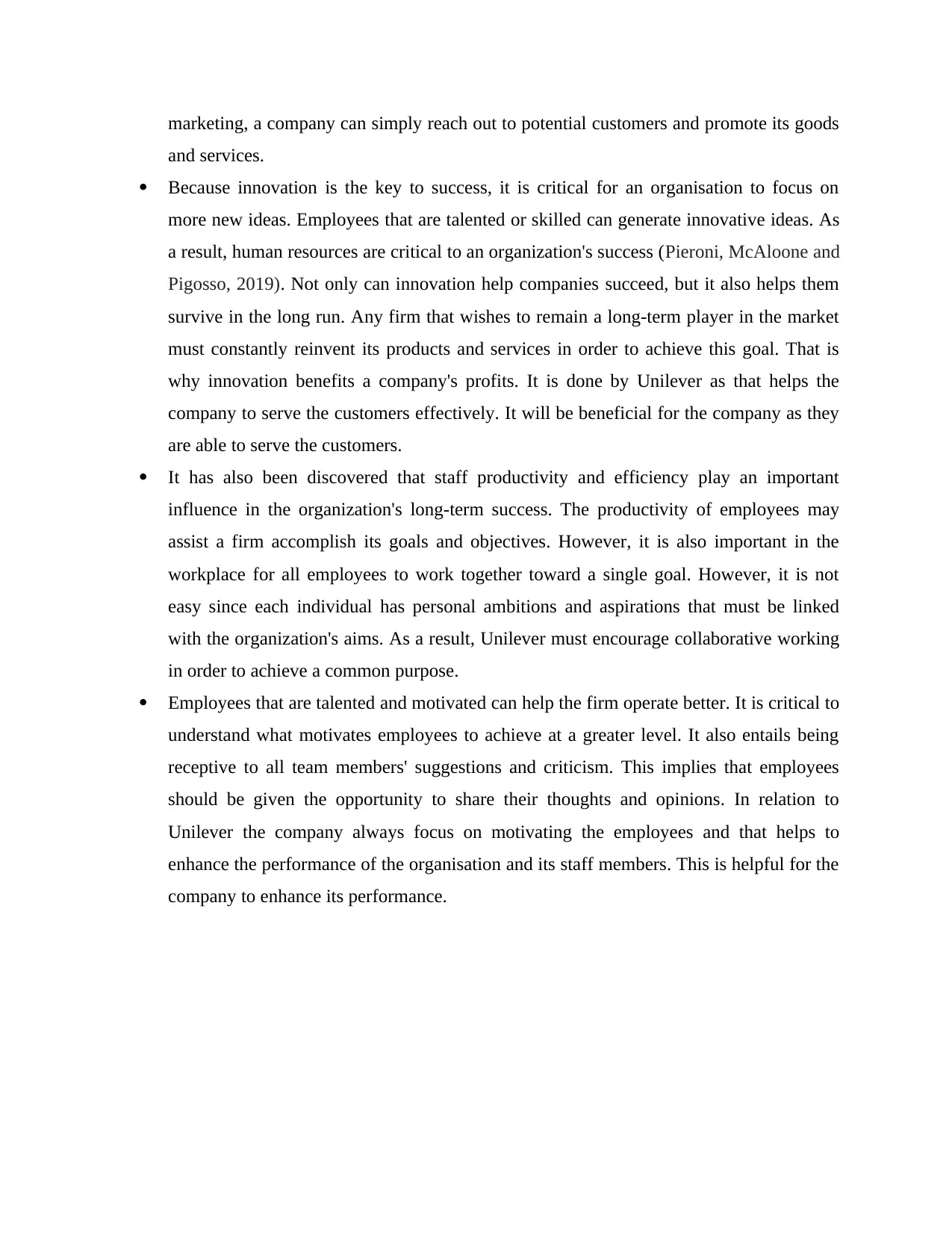
marketing, a company can simply reach out to potential customers and promote its goods
and services.
Because innovation is the key to success, it is critical for an organisation to focus on
more new ideas. Employees that are talented or skilled can generate innovative ideas. As
a result, human resources are critical to an organization's success (Pieroni, McAloone and
Pigosso, 2019). Not only can innovation help companies succeed, but it also helps them
survive in the long run. Any firm that wishes to remain a long-term player in the market
must constantly reinvent its products and services in order to achieve this goal. That is
why innovation benefits a company's profits. It is done by Unilever as that helps the
company to serve the customers effectively. It will be beneficial for the company as they
are able to serve the customers.
It has also been discovered that staff productivity and efficiency play an important
influence in the organization's long-term success. The productivity of employees may
assist a firm accomplish its goals and objectives. However, it is also important in the
workplace for all employees to work together toward a single goal. However, it is not
easy since each individual has personal ambitions and aspirations that must be linked
with the organization's aims. As a result, Unilever must encourage collaborative working
in order to achieve a common purpose.
Employees that are talented and motivated can help the firm operate better. It is critical to
understand what motivates employees to achieve at a greater level. It also entails being
receptive to all team members' suggestions and criticism. This implies that employees
should be given the opportunity to share their thoughts and opinions. In relation to
Unilever the company always focus on motivating the employees and that helps to
enhance the performance of the organisation and its staff members. This is helpful for the
company to enhance its performance.
and services.
Because innovation is the key to success, it is critical for an organisation to focus on
more new ideas. Employees that are talented or skilled can generate innovative ideas. As
a result, human resources are critical to an organization's success (Pieroni, McAloone and
Pigosso, 2019). Not only can innovation help companies succeed, but it also helps them
survive in the long run. Any firm that wishes to remain a long-term player in the market
must constantly reinvent its products and services in order to achieve this goal. That is
why innovation benefits a company's profits. It is done by Unilever as that helps the
company to serve the customers effectively. It will be beneficial for the company as they
are able to serve the customers.
It has also been discovered that staff productivity and efficiency play an important
influence in the organization's long-term success. The productivity of employees may
assist a firm accomplish its goals and objectives. However, it is also important in the
workplace for all employees to work together toward a single goal. However, it is not
easy since each individual has personal ambitions and aspirations that must be linked
with the organization's aims. As a result, Unilever must encourage collaborative working
in order to achieve a common purpose.
Employees that are talented and motivated can help the firm operate better. It is critical to
understand what motivates employees to achieve at a greater level. It also entails being
receptive to all team members' suggestions and criticism. This implies that employees
should be given the opportunity to share their thoughts and opinions. In relation to
Unilever the company always focus on motivating the employees and that helps to
enhance the performance of the organisation and its staff members. This is helpful for the
company to enhance its performance.
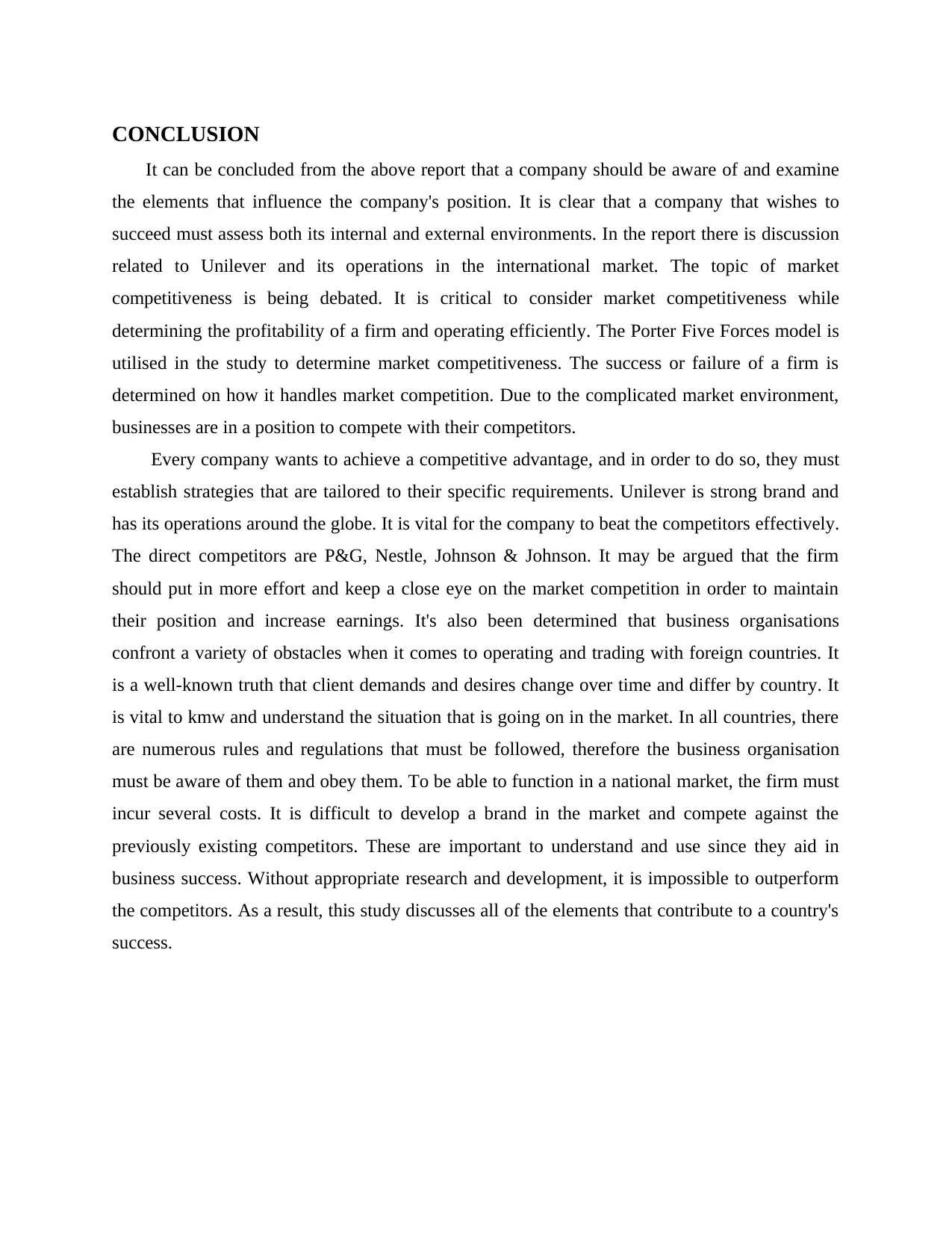
CONCLUSION
It can be concluded from the above report that a company should be aware of and examine
the elements that influence the company's position. It is clear that a company that wishes to
succeed must assess both its internal and external environments. In the report there is discussion
related to Unilever and its operations in the international market. The topic of market
competitiveness is being debated. It is critical to consider market competitiveness while
determining the profitability of a firm and operating efficiently. The Porter Five Forces model is
utilised in the study to determine market competitiveness. The success or failure of a firm is
determined on how it handles market competition. Due to the complicated market environment,
businesses are in a position to compete with their competitors.
Every company wants to achieve a competitive advantage, and in order to do so, they must
establish strategies that are tailored to their specific requirements. Unilever is strong brand and
has its operations around the globe. It is vital for the company to beat the competitors effectively.
The direct competitors are P&G, Nestle, Johnson & Johnson. It may be argued that the firm
should put in more effort and keep a close eye on the market competition in order to maintain
their position and increase earnings. It's also been determined that business organisations
confront a variety of obstacles when it comes to operating and trading with foreign countries. It
is a well-known truth that client demands and desires change over time and differ by country. It
is vital to kmw and understand the situation that is going on in the market. In all countries, there
are numerous rules and regulations that must be followed, therefore the business organisation
must be aware of them and obey them. To be able to function in a national market, the firm must
incur several costs. It is difficult to develop a brand in the market and compete against the
previously existing competitors. These are important to understand and use since they aid in
business success. Without appropriate research and development, it is impossible to outperform
the competitors. As a result, this study discusses all of the elements that contribute to a country's
success.
It can be concluded from the above report that a company should be aware of and examine
the elements that influence the company's position. It is clear that a company that wishes to
succeed must assess both its internal and external environments. In the report there is discussion
related to Unilever and its operations in the international market. The topic of market
competitiveness is being debated. It is critical to consider market competitiveness while
determining the profitability of a firm and operating efficiently. The Porter Five Forces model is
utilised in the study to determine market competitiveness. The success or failure of a firm is
determined on how it handles market competition. Due to the complicated market environment,
businesses are in a position to compete with their competitors.
Every company wants to achieve a competitive advantage, and in order to do so, they must
establish strategies that are tailored to their specific requirements. Unilever is strong brand and
has its operations around the globe. It is vital for the company to beat the competitors effectively.
The direct competitors are P&G, Nestle, Johnson & Johnson. It may be argued that the firm
should put in more effort and keep a close eye on the market competition in order to maintain
their position and increase earnings. It's also been determined that business organisations
confront a variety of obstacles when it comes to operating and trading with foreign countries. It
is a well-known truth that client demands and desires change over time and differ by country. It
is vital to kmw and understand the situation that is going on in the market. In all countries, there
are numerous rules and regulations that must be followed, therefore the business organisation
must be aware of them and obey them. To be able to function in a national market, the firm must
incur several costs. It is difficult to develop a brand in the market and compete against the
previously existing competitors. These are important to understand and use since they aid in
business success. Without appropriate research and development, it is impossible to outperform
the competitors. As a result, this study discusses all of the elements that contribute to a country's
success.
Paraphrase This Document
Need a fresh take? Get an instant paraphrase of this document with our AI Paraphraser
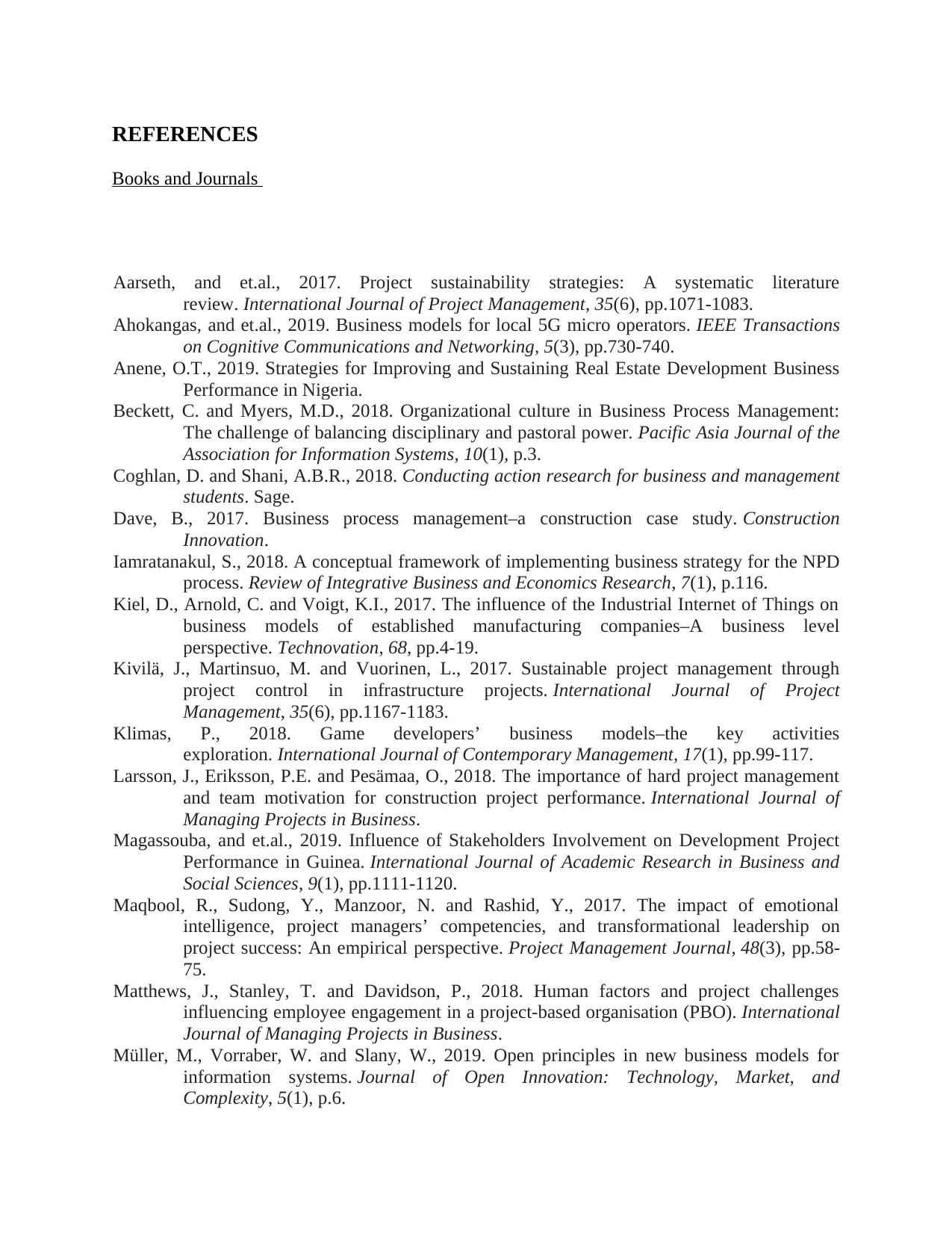
REFERENCES
Books and Journals
Aarseth, and et.al., 2017. Project sustainability strategies: A systematic literature
review. International Journal of Project Management, 35(6), pp.1071-1083.
Ahokangas, and et.al., 2019. Business models for local 5G micro operators. IEEE Transactions
on Cognitive Communications and Networking, 5(3), pp.730-740.
Anene, O.T., 2019. Strategies for Improving and Sustaining Real Estate Development Business
Performance in Nigeria.
Beckett, C. and Myers, M.D., 2018. Organizational culture in Business Process Management:
The challenge of balancing disciplinary and pastoral power. Pacific Asia Journal of the
Association for Information Systems, 10(1), p.3.
Coghlan, D. and Shani, A.B.R., 2018. Conducting action research for business and management
students. Sage.
Dave, B., 2017. Business process management–a construction case study. Construction
Innovation.
Iamratanakul, S., 2018. A conceptual framework of implementing business strategy for the NPD
process. Review of Integrative Business and Economics Research, 7(1), p.116.
Kiel, D., Arnold, C. and Voigt, K.I., 2017. The influence of the Industrial Internet of Things on
business models of established manufacturing companies–A business level
perspective. Technovation, 68, pp.4-19.
Kivilä, J., Martinsuo, M. and Vuorinen, L., 2017. Sustainable project management through
project control in infrastructure projects. International Journal of Project
Management, 35(6), pp.1167-1183.
Klimas, P., 2018. Game developers’ business models–the key activities
exploration. International Journal of Contemporary Management, 17(1), pp.99-117.
Larsson, J., Eriksson, P.E. and Pesämaa, O., 2018. The importance of hard project management
and team motivation for construction project performance. International Journal of
Managing Projects in Business.
Magassouba, and et.al., 2019. Influence of Stakeholders Involvement on Development Project
Performance in Guinea. International Journal of Academic Research in Business and
Social Sciences, 9(1), pp.1111-1120.
Maqbool, R., Sudong, Y., Manzoor, N. and Rashid, Y., 2017. The impact of emotional
intelligence, project managers’ competencies, and transformational leadership on
project success: An empirical perspective. Project Management Journal, 48(3), pp.58-
75.
Matthews, J., Stanley, T. and Davidson, P., 2018. Human factors and project challenges
influencing employee engagement in a project-based organisation (PBO). International
Journal of Managing Projects in Business.
Müller, M., Vorraber, W. and Slany, W., 2019. Open principles in new business models for
information systems. Journal of Open Innovation: Technology, Market, and
Complexity, 5(1), p.6.
Books and Journals
Aarseth, and et.al., 2017. Project sustainability strategies: A systematic literature
review. International Journal of Project Management, 35(6), pp.1071-1083.
Ahokangas, and et.al., 2019. Business models for local 5G micro operators. IEEE Transactions
on Cognitive Communications and Networking, 5(3), pp.730-740.
Anene, O.T., 2019. Strategies for Improving and Sustaining Real Estate Development Business
Performance in Nigeria.
Beckett, C. and Myers, M.D., 2018. Organizational culture in Business Process Management:
The challenge of balancing disciplinary and pastoral power. Pacific Asia Journal of the
Association for Information Systems, 10(1), p.3.
Coghlan, D. and Shani, A.B.R., 2018. Conducting action research for business and management
students. Sage.
Dave, B., 2017. Business process management–a construction case study. Construction
Innovation.
Iamratanakul, S., 2018. A conceptual framework of implementing business strategy for the NPD
process. Review of Integrative Business and Economics Research, 7(1), p.116.
Kiel, D., Arnold, C. and Voigt, K.I., 2017. The influence of the Industrial Internet of Things on
business models of established manufacturing companies–A business level
perspective. Technovation, 68, pp.4-19.
Kivilä, J., Martinsuo, M. and Vuorinen, L., 2017. Sustainable project management through
project control in infrastructure projects. International Journal of Project
Management, 35(6), pp.1167-1183.
Klimas, P., 2018. Game developers’ business models–the key activities
exploration. International Journal of Contemporary Management, 17(1), pp.99-117.
Larsson, J., Eriksson, P.E. and Pesämaa, O., 2018. The importance of hard project management
and team motivation for construction project performance. International Journal of
Managing Projects in Business.
Magassouba, and et.al., 2019. Influence of Stakeholders Involvement on Development Project
Performance in Guinea. International Journal of Academic Research in Business and
Social Sciences, 9(1), pp.1111-1120.
Maqbool, R., Sudong, Y., Manzoor, N. and Rashid, Y., 2017. The impact of emotional
intelligence, project managers’ competencies, and transformational leadership on
project success: An empirical perspective. Project Management Journal, 48(3), pp.58-
75.
Matthews, J., Stanley, T. and Davidson, P., 2018. Human factors and project challenges
influencing employee engagement in a project-based organisation (PBO). International
Journal of Managing Projects in Business.
Müller, M., Vorraber, W. and Slany, W., 2019. Open principles in new business models for
information systems. Journal of Open Innovation: Technology, Market, and
Complexity, 5(1), p.6.
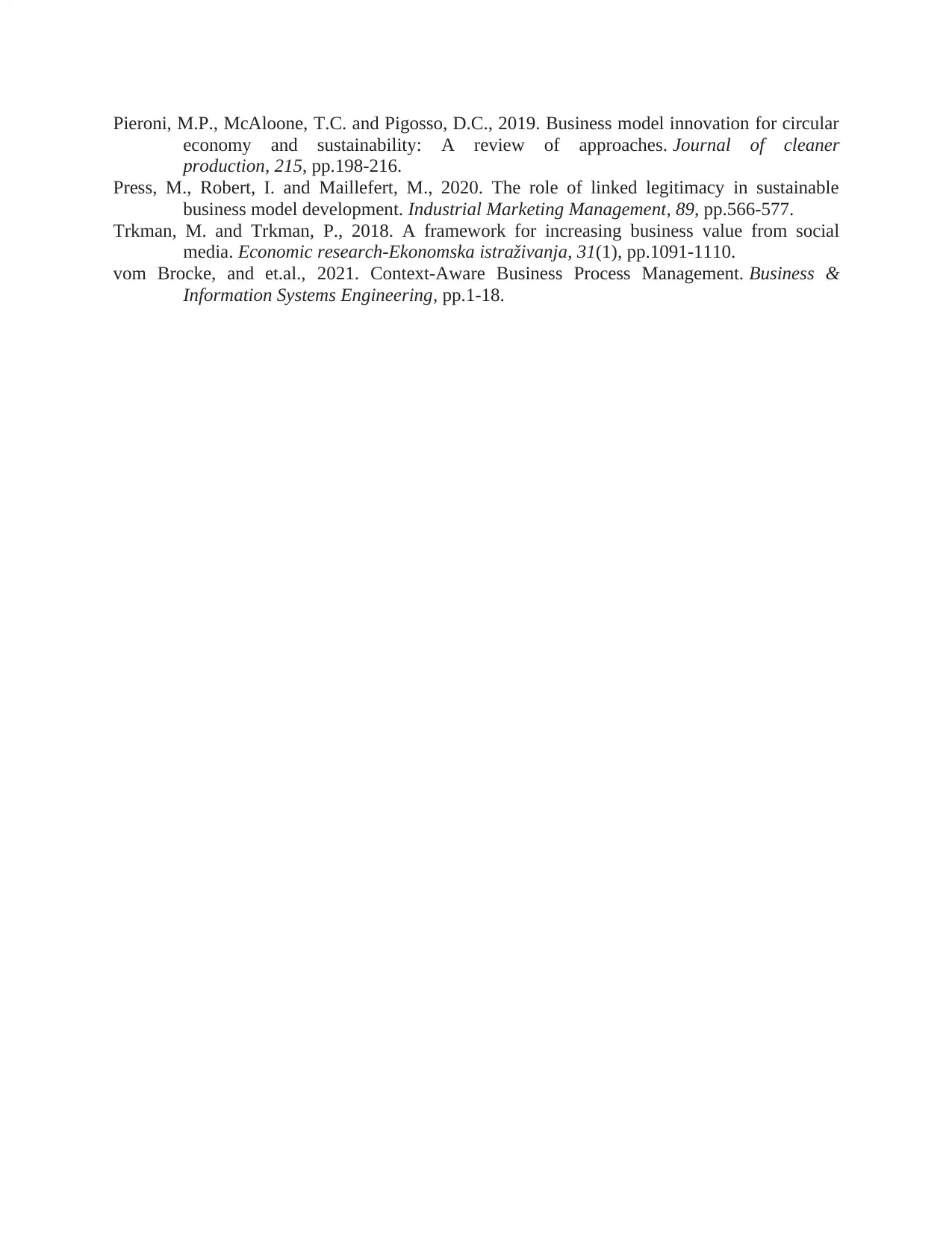
Pieroni, M.P., McAloone, T.C. and Pigosso, D.C., 2019. Business model innovation for circular
economy and sustainability: A review of approaches. Journal of cleaner
production, 215, pp.198-216.
Press, M., Robert, I. and Maillefert, M., 2020. The role of linked legitimacy in sustainable
business model development. Industrial Marketing Management, 89, pp.566-577.
Trkman, M. and Trkman, P., 2018. A framework for increasing business value from social
media. Economic research-Ekonomska istraživanja, 31(1), pp.1091-1110.
vom Brocke, and et.al., 2021. Context-Aware Business Process Management. Business &
Information Systems Engineering, pp.1-18.
economy and sustainability: A review of approaches. Journal of cleaner
production, 215, pp.198-216.
Press, M., Robert, I. and Maillefert, M., 2020. The role of linked legitimacy in sustainable
business model development. Industrial Marketing Management, 89, pp.566-577.
Trkman, M. and Trkman, P., 2018. A framework for increasing business value from social
media. Economic research-Ekonomska istraživanja, 31(1), pp.1091-1110.
vom Brocke, and et.al., 2021. Context-Aware Business Process Management. Business &
Information Systems Engineering, pp.1-18.
1 out of 15
Related Documents
Your All-in-One AI-Powered Toolkit for Academic Success.
+13062052269
info@desklib.com
Available 24*7 on WhatsApp / Email
![[object Object]](/_next/static/media/star-bottom.7253800d.svg)
Unlock your academic potential
© 2024 | Zucol Services PVT LTD | All rights reserved.





